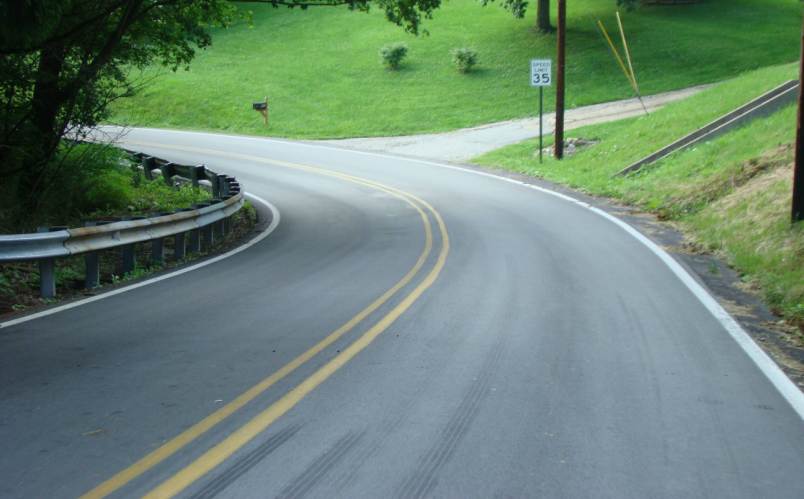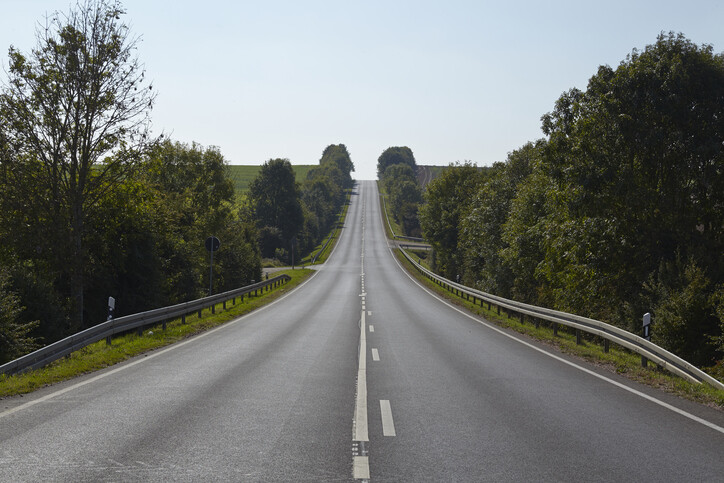A highway curve is an arc which connects two straight lines which are separated by some angle called deflection angle. This situation occurs where the alignment of a roadway or railway changes its direction because of unavoidable objects or conditions. There are two types of curves in highway construction which range from horizontal curve and vertical curve. Curves are provided whenever a road changes its direction from right to S (vice versa) or changes its alignment from up to down (vice versa). Curves are a critical element in the pavement design. They are provided with a maximum speed limit that should be followed very strictly. Following the speed limit becomes essential as the exceed in speed may lead to the chances of the vehicle becoming out of control while negotiating a turn and thus increase the odds of fatal accidents. Also, it is very necessary that appropriate safety measures be adopted at all horizontal and vertical curves to make the infrastructure road user friendly and decrease the risks of hazardous circumstances.
Importance of curves in highway
- If there is a sudden obstruction in the mid way of the highway such as mountains, Rocks etc.. which are impossible to move so a gradual curvature is provided to move forward towards the destination.
- Highways are generally straight roads for longer lengths so there may be a higher chance of occurring accidents due to overspending, or drowsy driving.
- If the curvature is provided the driver gets conscious and controls his speed and drowsiness while driving.
- Drowsiness is the main cause of accidents on highways, if curve is provided on the highway the driver becomes alert and respond to the curvature
- Gradual change in direction or orientation in the alignment can be made by providing the curves.
- Road curves are provided so as to get comfort to the passengers.
- Gradual change in the direction or orientation in the alignment can be made by providing the curves.
- Curves are provided so as to get easy turning in case of road and track
Different types of highway curves
There are two types of curves – Horizontal and Vertical curves. Each of them comes with various subcategories, each of them is explained below.
Horizontal curves
The curve provided in the horizontal plane of ground or earth is called a horizontal curve. It connects two straight lines which are in the same level but having different or the same directions. There are different types of horizontal curves, each of them is explained below.
Simple circular curve
It is a curve consisting of a single arc with a constant radius connecting the two tangents. It is a type of horizontal curve used most in common. A simple arc provided in the road or railway track to impose a curve between the two straight lines is the simple circular curve. The smaller is the degree of curve, the flatter is the curve and vice versa. The sharpness of a simple curve is also determined by radius R. Large radius are flat whereas small radius are sharp. A simple curve is normally represented by the length of its radius or by the degree of curve
Compound curve
It is a curve made up of two or more circular arcs of successively shorter or longer radii, joined tangentially without reversal of curvature, and used on some railroad tracks and highways as an easement curve to provide a less abrupt transition from tangent to full curve or vice versa. Since their tangent lengths vary, compound curves fit the topography much better than simple curves. These curves easily adapt to mountainous terrain or areas cut by large, winding rivers. However, since compound curves are more hazardous than simple curves, they should never be used where a simple curve will do.

Reverse curve
A reverse curve is composed of two or more simple curves turning in opposite directions. Their points of intersection lie on opposite ends of a common tangent, and the PT of the first curve is coincident with the PC of the second. This point is called the point of reverse curvature (PRC). A reverse curve is composed of two arcs of equal or different radii bending or curving in opposite directions with common tangent at their junction, their centers being on opposite sides of the curve.
Track transition curve
A track transition curve, or spiral easement, is a mathematically-calculated curve on a section of highway, in which a straight section changes into a curve. It is designed to prevent sudden changes in lateral In plane (viewed from above), the start of the transition of the horizontal curve is at infinite radius, and at the end of the transition, it has the same radius as the curve itself and so forms a very broad spiral. At the same time, in the vertical plane, the outside of the curve is gradually raised until the correct degree of bank is reached.
Spiral curve
Spiral curves are generally used to provide a gradual change in curvature from a straight section of road to a curved section. They assist the driver by providing a natural path to follow. Spiral curves also improve the appearance of circular curves by reducing the break in alignment perceived by drivers. The use of a spiral is about making the road or track follow the same form that the vehicle naturally takes. In a car, you don’t go directly from going straight to fully turning. There is a transition area where you slowly turn the steering wheel. On highways, the lanes are wide enough that you can drive a spiral just by moving from one side of the lane to the other.
Vertical curves
These curves are provided to change the slope in the road and may or may not be symmetrical. They are parabolic and not circular like horizontal curves. Identifying the proper grade and the safe passing sight distance is the main design criterion of the vertical curve, crest vertical curve the length should be enough to provide safe stopping sight distance and in sag vertical curve the length is important as it influences the factors such as headlight sight distance, rider comfort and drainage requirements. There are two types of vertical curves discussed below/
Valley/ Sag Curve
Valley curves or sag curves are vertical curves with convexity downwards. In valley curves, the centrifugal force will be acting downwards along with the weight of the vehicle, and hence impact to the vehicle will be more. This will result in jerking of the vehicle and cause discomfort to the passengers. Thus the most important design factors considered in valley curves are- impact-free movement of vehicles at design speed and availability of stopping sight distance under headlight of vehicles for night driving. The valley curve is made fully transitional by providing two similar transition curves of equal length.

Summit curve
Summit curves are vertical curves with gradient upwards. Sight distance requirements for the safety is most important on summit curves. The stopping sight distance or absolute minimum sight distance should be provided on these curves and where overtaking is not prohibited, overtaking sight distance or intermediate sight distance should be provided as far as possible. When a fast moving vehicle travels along a summit curve, there is less discomfort to the passengers. This is because the centrifugal force will be acting upwards while the vehicle negotiates a summit curve which is against the gravity and hence a part of the tyre pressure is relieved. Also if the curve is provided with adequate sight distance, the length would be sufficient to ease the shock due to change in gradient.
Conclusion
The curves play a vital role in the geometric design of highway alignments, so it must be properly designed so as to provide safety, comfort and convenience at the time of driving the vehicles or train on road curves. The design of the curve is dependent on the intended design speed for the roadway, as well as other factors including drainage and friction.

